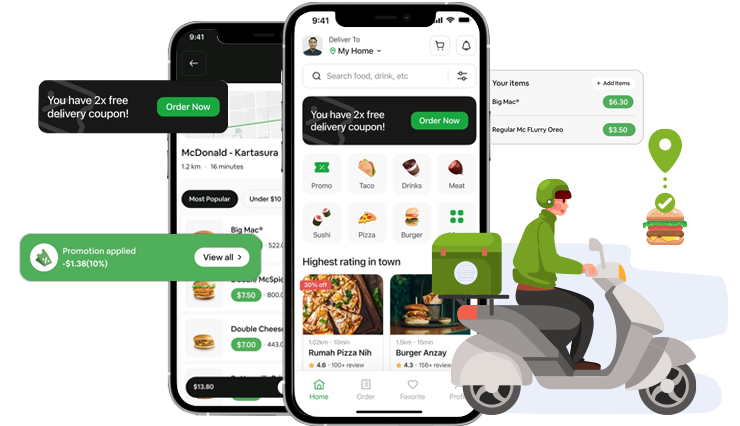Are you intrigued by the success of food delivery apps like UberEats and want to create a similar app of your own? Developing an UberEats clone app can be a rewarding venture, allowing you to tap into the growing demand for convenient food delivery services. In this guide, we’ll walk you through the essential steps and considerations to create your own successful food delivery app.
Introduction: Understanding the UberEats Model
Before embarking on your app development journey, it’s crucial to understand the core features and functionalities of UberEats. This will serve as a foundation for creating a successful clone app that caters to your target audience’s needs.
Must-Have Features in UberEats Clone
When building an UberEats clone, it’s imperative to incorporate these essential features to create a platform that users and businesses will love.
User-Friendly Interface and Seamless Navigation
A clutter-free and intuitive interface sets the foundation for a positive user experience. The platform should allow users to effortlessly browse restaurants, view menus, and place orders. Smooth navigation enhances user engagement and encourages repeat business.
Robust Search and Filtering Options
Enabling users to search for specific cuisines, dishes, or restaurants enhances their ability to find exactly what they crave. Implementing advanced filters based on dietary preferences, price ranges, and delivery times provides a personalized experience.
Real-Time Order Tracking
The ability to track orders in real-time provides users with transparency and reassurance. Integrating GPS technology allows customers to monitor the progress of their orders from the moment they’re placed to the moment they arrive at their doorstep.
Secure Payment Gateways
A variety of secure payment options instills confidence in users and facilitates seamless transactions. Incorporating popular payment methods such as credit cards, digital wallets, and online banking ensures convenience and accessibility.
Restaurant Dashboard and Menu Management
Streamlining the process for restaurants to manage their menus, update item availability, and track orders is vital. A dedicated restaurant dashboard simplifies these tasks, fostering a positive relationship between the platform and its partner establishments.
Efficient Dispatch and Delivery Management
Efficiently managing the dispatch and delivery process is essential for timely and accurate order fulfillment. An intelligent system that optimizes delivery routes and assigns orders to available drivers minimizes delivery times and enhances customer satisfaction.
Ratings and Reviews
Enabling customers to rate and review their dining experiences contributes to the credibility of the platform. Positive reviews serve as social proof, attracting more users, while constructive feedback helps restaurants improve their offerings.
Customer Support and Help Center
A responsive customer support system is essential for addressing user queries, resolving issues, and providing assistance. A well-organized help center with frequently asked questions (FAQs) and guides offers self-service options.
Multi-Platform Compatibility
To reach a wider audience, the UberEats clone should be compatible with various devices and operating systems. Offering a seamless experience on web browsers, smartphones, and tablets ensures accessibility for all users.
Promotions and Loyalty Programs
Implementing promotional campaigns, discounts, and loyalty programs encourages user engagement and repeat business. These incentives not only attract new customers but also reward loyal patrons.
Social Media Integration
Integrating social media functionalities allows users to easily share their orders and experiences. This organic promotion can lead to increased brand visibility and user acquisition.
Analytics and Reporting
Data-driven insights empower administrators and restaurant owners to make informed decisions. Comprehensive analytics and reporting tools offer valuable information on order trends, customer preferences, and operational performance.
How to Develop an UberEats Clone App?
Market Research and Validation
Thorough market research is essential to identify your target market, analyze competitors, and understand consumer preferences. Validate your app idea by gathering feedback through surveys and focus groups to ensure you’re developing a product that meets real-world demands.
Designing User-Friendly Interfaces
Create intuitive and visually appealing user interfaces for both customers and restaurant owners. A seamless and user-friendly design enhances the overall app experience, making it easy for users to browse menus, place orders, and track deliveries.
Building the Backend Infrastructure
The backend of your app is the engine that powers all operations. Choose a reliable technology stack to build a robust infrastructure that handles user accounts, menu management, order processing, and more.
Implementing Real-Time Order Tracking
Integrate real-time order tracking to keep customers informed about the status of their deliveries. This feature enhances transparency and builds trust, as users can track their orders from preparation to doorstep delivery.
Securing Payment Gateways
Ensure the security of online transactions by integrating trusted and secure payment gateways. Protecting customer data and providing various payment options contribute to a seamless and trustworthy app experience.
Partnering with Restaurants and Establishments
Collaborate with local restaurants and food establishments to list their menus on your app. Building a strong network of partners expands your app’s offerings and provides users with a wide variety of food choices.
Developing the Delivery Driver Module
Create a dedicated module for delivery drivers, allowing them to manage their availability, accept orders, and navigate efficiently to ensure timely deliveries.
Testing for Quality Assurance
Thoroughly test your app to identify and resolve any bugs, glitches, or usability issues. Rigorous quality assurance is essential to ensure a smooth and error-free user experience.
Launching Your UberEats Clone App
Plan a strategic launch for your app, focusing on building anticipation and excitement among potential users. A successful launch involves effective marketing, promotions, and user onboarding.
Marketing and Promotion Strategies
Utilize digital marketing, social media, and influencer collaborations to promote your app. Offer attractive discounts and referral programs to encourage user adoption and retention.
Scaling Your Business
As your app gains traction, focus on scaling your operations. Optimize your app’s performance, expand your restaurant partnerships, and ensure your delivery fleet meets increasing demand.
Continuous Improvement and Updates
Regularly update your app with new features and improvements based on user feedback and emerging industry trends. Continuous innovation keeps your app relevant and competitive.
Customer Feedback and Support
Prioritize customer feedback and provide excellent customer support. Address user concerns promptly and use feedback to enhance the app’s overall user experience.
Conclusion
Developing an UberEats clone app requires careful planning, attention to detail, and a user-centric approach. By following this comprehensive guide, you can create a successful food delivery app that caters to the needs and preferences of modern consumers.



